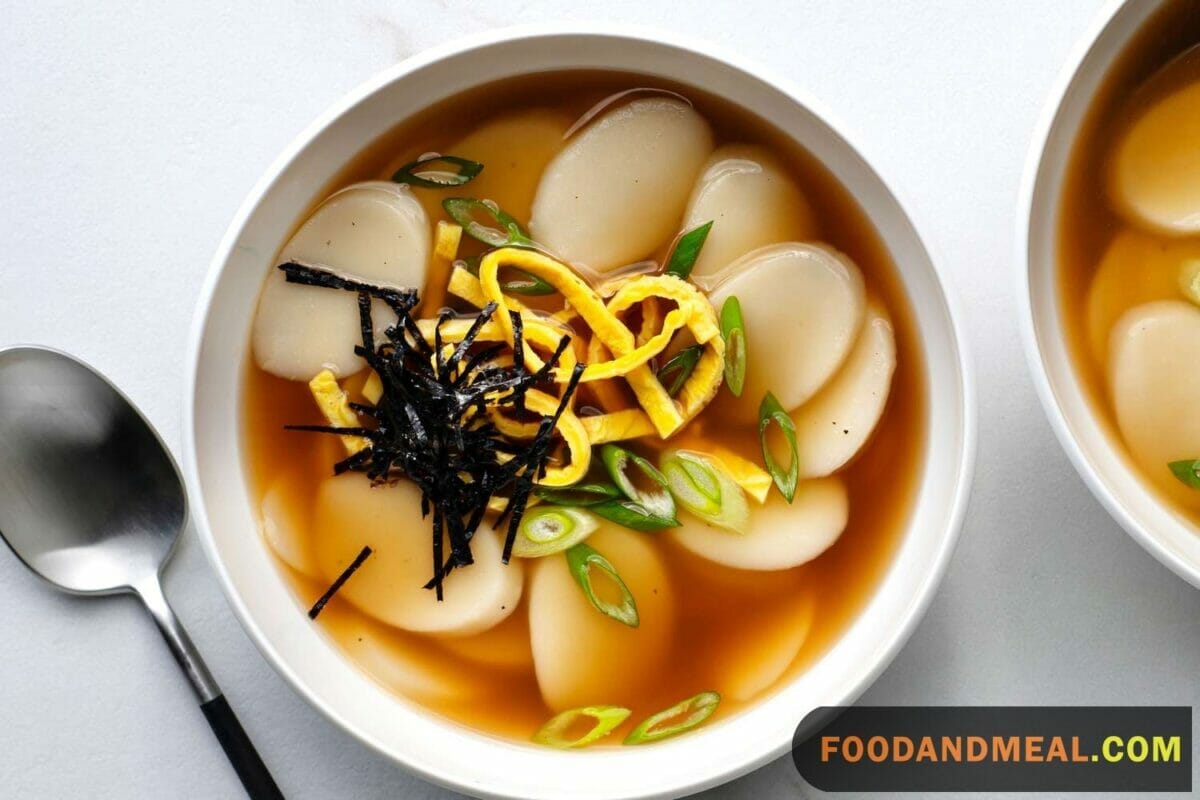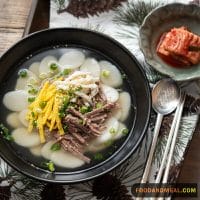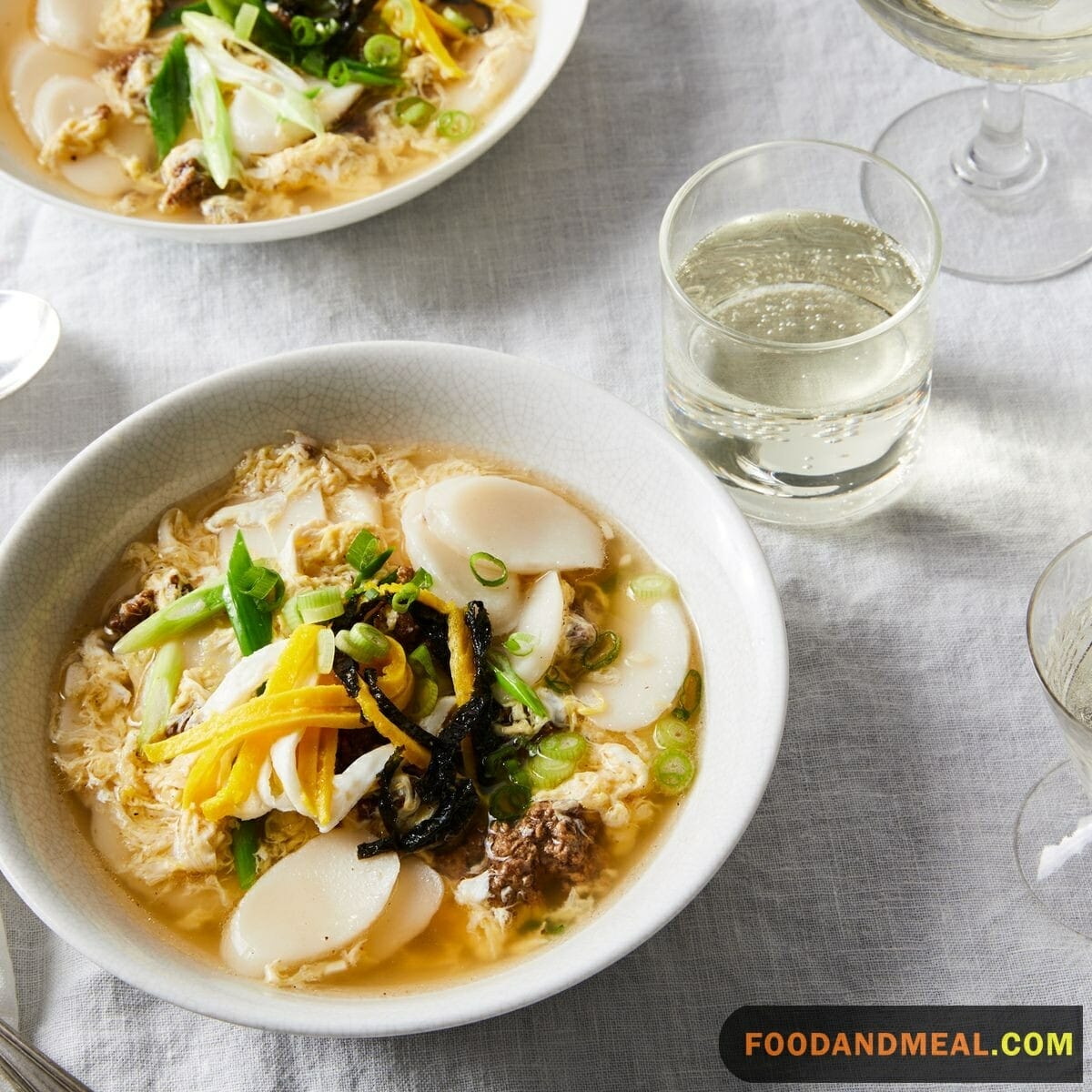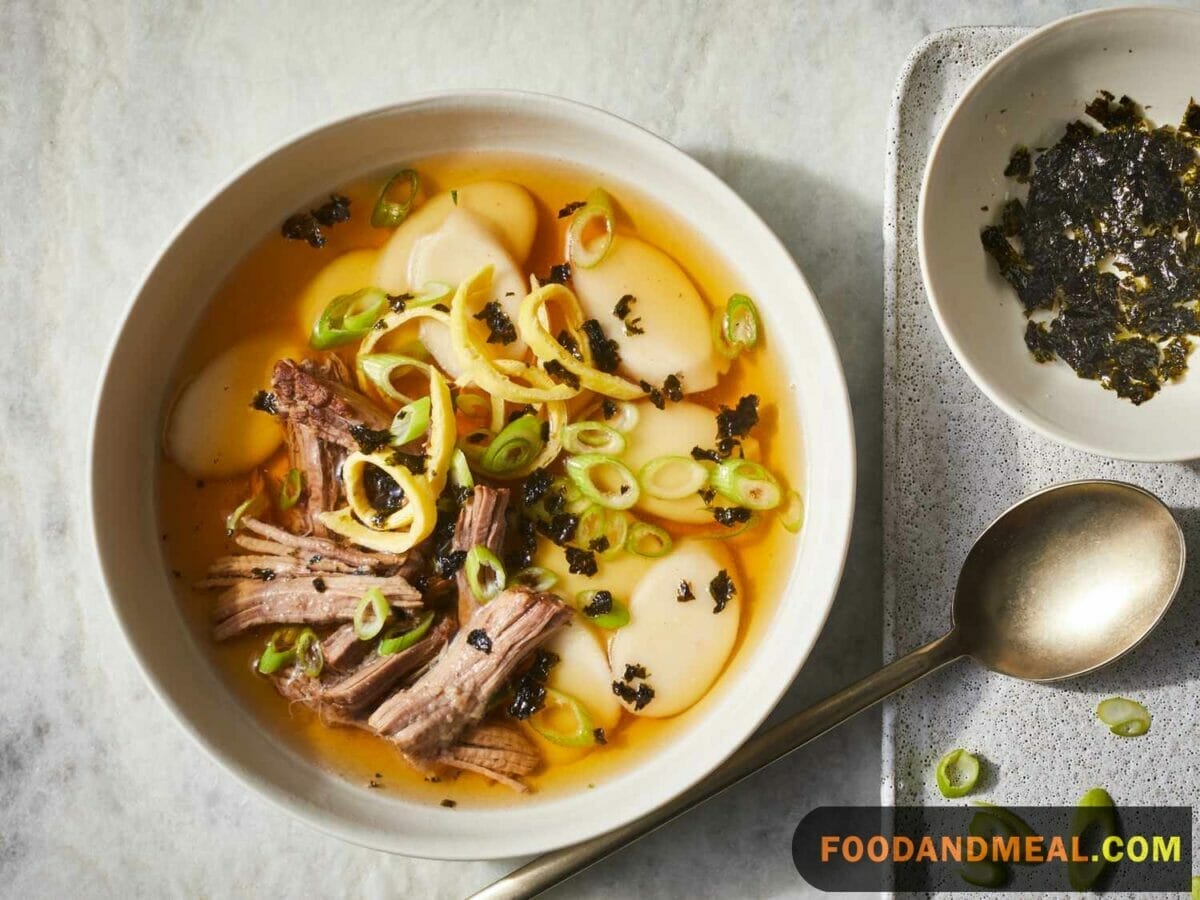As a child, I fondly remember my grandmother’s nourishing rice cake soup warming me up on frigid winter days. The soft chewy rice cakes and beef broth were the ultimate comfort food. Now, as part of the passionate team at Food and Meal sharing cultural recipes, I’m delighted to bring this soulful dish into your kitchens.
Rice cake soup, called tteokguk in Korean, holds a profoundly special place in my heart. It’s traditionally eaten on New Year’s Day, the rice cakes symbolizing prosperity for the coming year. As I gently drop the slippery white slices into the steaming broth, I feel immense gratitude for my heritage passing down this tradition.
In my version, I use dashi stock to let the flavors of the rice cakes shine through. Thin slices of beef cook quickly, while zucchini ribbons add a pop of color. Then I top each serving with a drizzle of sesame oil and sprinkle of toasted seaweed flakes. This adds a lovely nutty, ocean-like contrast.
As you gather with your loved ones to welcome the new year, I hope this rice cake soup fills you up in body and spirit. Let it be a bridge connecting us across cultures through the universal language of food. Please tell me your stories! I’d be delighted to hear how this recipe makes its way into your lives.

Rice Cake Soup Recipe

RICE CAKE SOUP
Equipment
Ingredients
- 1 package Korean flat oval rice cakes
- 6 cups Anchovy Stock (here), Beef Stock (here), or chicken broth (if using store-bought broth, see Substitution Tip following)
- Soup soy sauce
- 1 teaspoon freshly ground black pepper
- 2 eggs, beaten
- 1 sheet dried seaweed, cut into thin slices
- 2 scallions, chopped, for garnish (optional)
Instructions
- Soak the rice cakes in cold water for about 20 minutes. Drain.
- In a medium stockpot over medium-high heat, add the stock and bring it to a boil. Season with soup soy sauce and the pepper, and stir.
- Reduce the heat to medium-low, add the rice cakes, and simmer until tender, about 10 minutes.
- While soup is cooking, cook the eggs into a thin, flat omelet. Cut the omelet into thin slices.
- To serve, ladle the soup into 4 individual bowls and garnish with the egg strips, seaweed strips, and scallions (if using).
Video
Notes
SUBSTITUTION TIP: For a vegetarian version, use vegetable broth. COOKING TIP: If you don’t want to soak the rice cakes beforehand, you don’t have to. You will need to add 6 to 8 minutes of cooking time, and your broth will be thicker.
INGREDIENT TIP: Common additions to this dish include beef strips and dumplings.
Nutrition
© Food And Meal
This website provides approximate nutrition information for convenience and as a courtesy only. Nutrition data is gathered primarily from the Spoonacular Database, whenever available, or otherwise other online calculators.
Cooking Tips

When it comes to preparing rice cake soup, I have a few little tips to ensure the broth soaks into every morsel. First, be sure not to overcook the rice cakes – you want them tender but still pleasantly chewy. Simmer them gently in the broth for just 2-3 minutes. Second, use a sharp knife to cut neat slices that won’t clump together. And third, let the finished soup sit for 5 minutes before serving so the flavors have time to mingle.
In terms of toppings, I love adding a drizzle of toasted sesame oil and sprinkle of crispy seaweed flakes. This adds a lovely nutty, ocean-like contrast. Thinly sliced scallions and a squeeze of lime also make bright finishing touches. And for some protein, you could top each bowl with a soft-boiled egg.
Serving Suggestions

Envision a Thai-inspired dessert duo by pairing the savory soup with the sweet and luscious Thai Mango Sticky Rice. For a rich and satisfying twist, accompany the soup with the Japanese Sesame Lamb Hot Pot, offering a delightful contrast in textures and flavors. Opt for a comforting breakfast or brunch by combining the hearty Rice Cake Soup with the light and airy Fluffy Greek Yogurt Pancakes. Embrace a Mediterranean touch with the Low-Potassium Lovely Linguine, providing a perfect accompaniment to the savory tones of the soup. Spice up your meal with the Spicy Thai Prawn Noodles, where bold and aromatic flavors harmonize with the comforting soup. For a Japanese fusion, enjoy Rice Cake Soup alongside the Japanese Gyoza Dumpling Hot Pot, introducing a delightful crunch to the overall experience. Refresh your palate with a Korean Watermelon Soju Cocktail, striking a balance with the warm and hearty soup. Complete your cozy and nutritious meal by pairing Rice Cake Soup with BLW Nutty Mashed Sweet Potatoes, offering a sweet and nutty counterpoint to the savory notes of the soup. These diverse suggestions aim to transform your dining experience into a culinary journey, celebrating the richness and versatility of Rice Cake Soup.
FAQs: Your Korean Rice Cake Soup Guide

- What Are the Essential Ingredients? The key components include rice cakes, broth, scallions, sesame seeds, and roasted seaweed.
- Can I Use Store-Bought Broth? Absolutely! Choose a high-quality vegetable or beef broth for authentic flavors.
- How Do I Achieve the Perfect Consistency? Cook the rice cakes until they are tender but still slightly chewy, ensuring the desired texture.
- How Do I Store Leftovers? Refrigerate in an airtight container. Reheat gently on the stovetop, adding a splash of broth to restore
- Can I Customize the Soup? Certainly! Experiment with add-ins like vegetables, tofu, or even a poached egg for a personalized touch.
- Is This Dish Suitable for Vegetarians? Absolutely. Opt for vegetable broth and customize the ingredients to suit your preferences.
- What Makes This Soup Special? Korean Rice Cake Soup carries cultural significance, often enjoyed during Lunar New Year celebrations.
- Can I Freeze Leftovers? While possible, it’s recommended to consume the soup freshly made for the best taste and texture.
- What is the Origin of This Dish? Korean Rice Cake Soup, known as “Tteokguk,” is a traditional dish served to celebrate birthdays and new beginnings.
- How Can I Make the Soup Spicier? Add a dash of Korean red pepper flakes (gochugaru) or chili paste (gochujang) for an extra kick of heat.
Conclusion
In conclusion, the journey through the world of Rice Cake Soup has been a flavorful exploration, embracing diverse culinary influences that promise to enchant your taste buds. The fusion of Thai, Japanese, Greek, and Korean elements creates a symphony of tastes and textures, turning a simple bowl of soup into a culinary adventure. At Food and Meal, we believe in the transformative power of food to bring joy and connection to our lives, and this exploration of Rice Cake Soup serves as a testament to that philosophy. Whether you choose to pair it with Thai Mango Sticky Rice, Japanese Sesame Lamb Hot Pot, or a refreshing Korean Watermelon Soju Cocktail, each suggestion aims to add depth and nuance to your dining experience. Visit foodandmeal.com for more culinary inspirations, recipes, and a celebration of the diverse world of food. Join us in this delightful journey, and let your kitchen become a canvas for creating memorable and satisfying meals. May your Rice Cake Soup adventures be filled with joy, flavor, and the warmth of shared moments around the table.
Hi! I'm Nazia of ‘Nazia Cooks’, a self-taught baker and cook residing in Chennai. Rooted in the rich South Indian culinary landscape, my palate has expanded to embrace global flavors. I revel in crafting fusion dishes, melding traditions to birth unique tastes.


